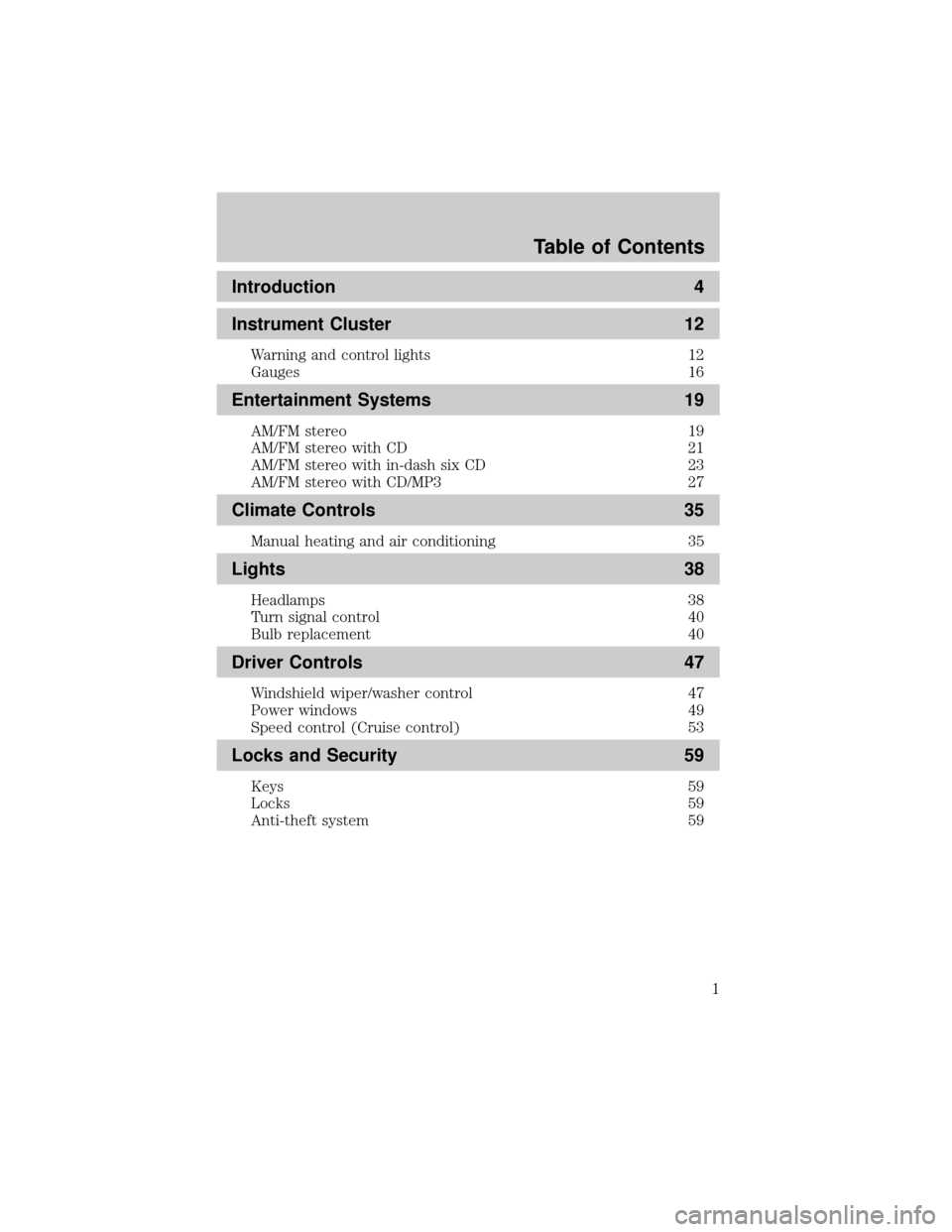air conditioning MAZDA MODEL B2300 2003 Owners Manual (in English)
[x] Cancel search | Manufacturer: MAZDA, Model Year: 2003, Model line: MODEL B2300, Model: MAZDA MODEL B2300 2003Pages: 248, PDF Size: 2.71 MB
Page 1 of 248

Introduction 4
Instrument Cluster 12
Warning and control lights 12
Gauges 16
Entertainment Systems 19
AM/FM stereo 19
AM/FM stereo with CD 21
AM/FM stereo with in-dash six CD 23
AM/FM stereo with CD/MP3 27
Climate Controls 35
Manual heating and air conditioning 35
Lights 38
Headlamps 38
Turn signal control 40
Bulb replacement 40
Driver Controls 47
Windshield wiper/washer control 47
Power windows 49
Speed control (Cruise control) 53
Locks and Security 59
Keys 59
Locks 59
Anti-theft system 59
Table of Contents
1
Page 36 of 248

4. Direct the outer instrument panel vents towards the side windows
To increase airflow to the outer instrument panel vents, close the vents
located in the middle of the instrument panel.
WARNING: Do not place objects on top of the instrument panel
as these objects may become projectiles in a collision or sudden
stop.
MANUAL HEATING AND AIR
CONDITIONING SYSTEM
1.Fan speed adjustment:
Controls the volume of air
circulated in the vehicle.
2.Temperature selection:
Controls the temperature of the
airflow in the vehicle.
3.Air flow selections:Controls the direction of the airflow in the
vehicle. See the following for a brief description on each control.
MAX A/C:Uses recirculated air to cool the vehicle. Air flows from the
instrument panel vents only.
A/C:Uses outside air to cool the vehicle. Air flows from the instrument
panel vents only.
:Distributes outside air through the instrument panel vents.
OFF:Outside air is shut out and the fan will not operate.
:Distributes outside air through the instrument panel vents and the
floor vents.
:Distributes outside air through the floor vents.
:Distributes outside air through the windshield defroster vents and
floor vents.
:Distributes outside air through the windshield defroster vents.
OPERATING TIPS
²To reduce fog build up on the windshield during humid weather, place
the air flow selector in the
position.
²To reduce humidity build up inside the vehicle: do not drive with the
air flow selector in the OFF or MAX A/C position.
Climate Controls
36
Page 115 of 248

WARNING: If you smell exhaust fumes inside your vehicle,
have your dealer inspect your vehicle immediately. Do not drive
if you smell exhaust fumes.
Important ventilating information
If the engine is idling while the vehicle is stopped for a long period of
time, open the windows at least 2.5 cm (one inch) or adjust the heating
or air conditioning to bring in fresh air.
BRAKES
Occasional brake noise is normal. If a metal-to-metal, continuous grinding
or continuous squeal sound is present, the brake linings may be worn-out
and should be inspected by a qualified service technician. If the vehicle
has continuous vibration or shudder in the steering wheel while braking,
the vehicle should be inspected by a qualified service technician.
Four-wheel anti-lock brake system (ABS)
This vehicle is equipped with an anti-lock braking system (ABS), a noise
from the hydraulic pump motor and pulsation in the pedal may be
observed during ABS braking events. Pedal pulsation coupled with noise
while braking under panic conditions or on loose gravel, bumps, wet or
snowy roads is normal and indicates proper functioning of the vehicle's
anti-lock brake system.
NOTE:The ABS performs a self-check after you start the engine and
begin to drive away.
A brief mechanical noise may be heard during this test. This is normal. If
a malfunction is found, the ABS warning light will come on. If the vehicle
has continuous vibration or shudder in the steering wheel while braking,
the vehicle should be inspected by an authorized Mazda dealership.
The ABS operates by detecting the
onset of wheel lockup during brake
applications and compensates for
this tendency. The wheels are
prevented from locking even when
the brakes are firmly applied. The
accompanying illustration depicts
the advantage of an ABS equipped
vehicle (on bottom) to a non-ABS
equipped vehicle (on top) during hard braking with loss of front braking
traction.
Driving
115
Page 242 of 248

driving off road .......................126
electronic shift ........................125
indicator light .........................125
preparing to drive your
vehicle .....................................118
Fuel ............................................208
calculating fuel economy .......215
cap ...........................................211
capacity ...................................232
choosing the right fuel ...........212
comparisons with EPA fuel
economy estimates .................218
detergent in fuel .....................214
filling your vehicle
with fuel ..................208, 211, 215
filter, specifications ................214
fuel pump shut-off switch .....140
improving fuel economy ........215
octane rating ...................213, 236
quality ......................................213
running out of fuel .................214
safety information relating to
automotive fuels .....................208
Fuel - flex fuel vehicle
(FFV) .........................208, 212±213
Fuses ..................................141±142
G
Gas cap (see Fuel cap) ............211
Gas mileage (see Fuel
economy) ...................................215
Gauges .........................................16
GAWR (Gross Axle Weight
Rating) .......................................129
calculating ...............................131
definition .................................129
driving with a heavy load ......129
location ....................................129GVWR (Gross Vehicle Weight
Rating) .......................................129
calculating .......................129, 131
definition .................................129
driving with a heavy load ......129
location ....................................129
H
Headlamps ...................................38
aiming ........................................39
bulb specifications ....................40
daytime running lights .............38
flash to pass ..............................39
high beam .................................39
replacing bulbs .........................41
turning on and off ....................38
Heating
heating and air
conditioning system ...........35±36
Hood ..........................................191
I
Ignition ...............................110, 236
Infant seats
(see Safety seats) .......................97
Inspection/maintenance (I/M)
testing ........................................219
Instrument panel
cleaning ...................................180
cluster ................................12, 180
lighting up panel and
interior .......................................39
location of components ............12
J
Jack ............................................152
positioning ...............................152
storage .............................152±154
Index
242